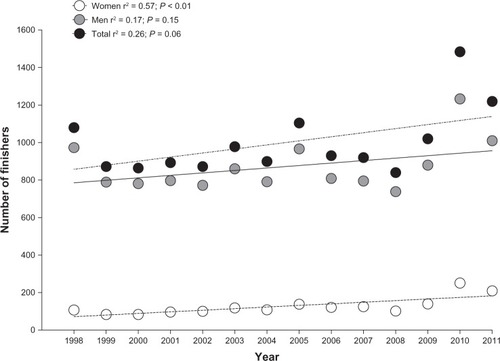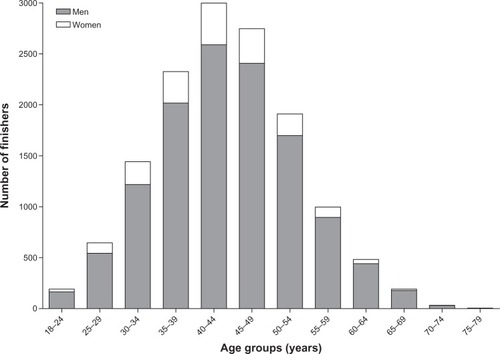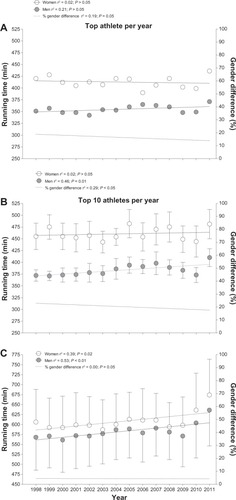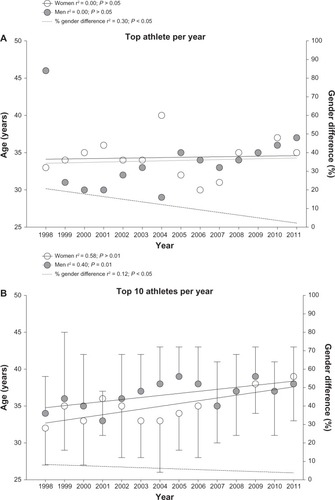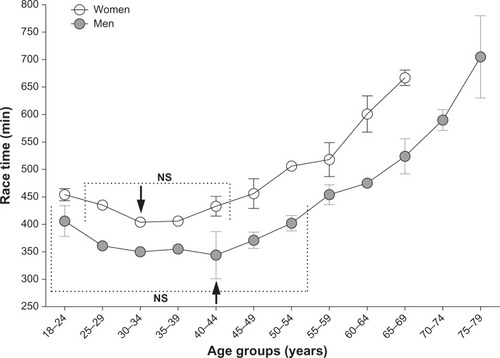Abstract
Background
The aims of the study were to examine the (a) participation, (b) difference in running times between the sexes, and (c) age-related decline in the running times of ultramarathoner women and men competing in the Swiss Alpine Marathon from 1998 to 2011.
Methods
The ultramarathoners competing in the Swiss Alpine Marathon were analyzed in terms of participation, difference in running times between the sexes, age of the fastest runners, and age-related decline in the fastest running times. The race covers a distance of 78 km, with a total altitude change of approximately 2260 m. A total of 12,194 men and 1781 women finished the race between 1998 and 2011.
Results
Women’s participation increased from approximately 10% in 1998 to approximately 16% in 2011 (r2 = 0.57; P = 0.001), but participation remained unchanged in men (r2 = 0.17; P > 0.05). Over the years, the top ten women showed no change in running times (r2 = 0.02; P > 0.05), whereas the top ten men’s running times increased (r2 = 0.46; P < 0.01). The age for peak running times increased over time both for the top ten women (r2 = 0.58; P < 0.01) and for the top ten men (r2 = 0.40; P = 0.01).
Conclusion
Among the top women, participation increased, the age for peak running times increased, and the running times remained unchanged. Among the men, however, the participation remained steady, and both the peak running-time age and the running times increased.
Introduction
Participation in marathon and ultramarathon running events – ultramarathons are extralong distance running events, longer than the traditional marathon distance of 42.195 km – has increased tremendously since the 1980s.Citation1–Citation6 Participation in 161 km ultramarathons in the USA increased in the early to mid-1980s, but has remained stable since 1986.Citation2,Citation3 In 1998, in North America, only twenty-one 161 km ultramarathon events were held, but the number of events increased to 53 per year in 2008.Citation1 This growth reflected an increased interest in ultra-endurance running by the participating athletes.Citation2
An individual’s performance in ultra-endurance running can be affected by different factors.Citation7 It has been shown that ageCitation5,Citation8 and sexCitation8–Citation10 can influence performance. As to sex, women’s performance progressed considerably over recent decades.Citation11 Despite women not being able to close the sex gap in marathon running, some authors suggested that the sex difference would disappear for running distances greater than that of a marathon.Citation12,Citation13 For instance, Hoffman showed there was no difference in 80 km and 161 km running performances between women and men who had matching 50 km running times.Citation14 In contrast, Coast et al analyzed the fastest running times of women and men for distances ranging from 100 m to 200 km and showed that men’s running speed was 12.4% faster than women’s. Moreover, as the distance increased so did the gap between the sexes.Citation15 Cheuvront et al reported a difference between the sexes of 8%–14% for running distances from 1500 m to 42 km.Citation16 In contrast, Speechly et al reported that women who were matched with men for a 42.2 km run were faster than men in a 90 km race.Citation13 The women achieved their performances by running at a higher average fraction of maximum oxygen uptake (V02 max).
The difference in running performance between men and women might be explained by differences in anthropometry and physiology. Men have a higher skeletal muscle mass than women do, which could cause the difference.Citation17 Men, having larger hearts, also have a higher stroke volume and therefore a higher cardiac output.Citation17 The vascularization of the skeletal muscle mass is lower in women, due to their lower blood volume. These two factors combined result in a lower oxygen capacity for women. Also, V02 max is 15% to 25% lower in female athletes than in males.Citation17
Several studies investigated the age-related decline in endurance and ultra-endurance performance.Citation5,Citation18–Citation20 For example, an analysis of male and female 100 km ultramarathoners showed that the fastest runners were 30- to 40-year-old men and 30- to 54-year-old women.Citation5 Similarly, Hoffman reported that the fastest average running time in a 161 km ultramarathon was achieved by athletes aged between 35 and 40.Citation3 Reaburn and Dascombe noted that maintaining both high-intensity and high-volume training could mitigate the age-related decrease in running performance.Citation21 However, beyond age 55 years, running performance decreased in both sexes, most pronouncedly in women.Citation21,Citation22
To date, no study has investigated the participation and running times of ultramarathoner women and men competing in high alpine terrain. The Swiss Alpine Marathon is one of the premier mountain ultramarathons in Europe (http://www.swissalpine.ch). The race covers a distance of 78 km and has a total altitude change of approximately 2260 m. The hilly trail and huge altitude change comprise an enormous challenge for the runners. The question arises whether younger athletes handle the hilly terrain better than older ones, since with increasing age, body fat increases and skeletal muscle mass decreases.Citation21 Indeed it might be possible that, in a mountain ultramarathon such as the Swiss Alpine Marathon, the age-related decline would be greater if compared to traditional ultramarathons. Regarding differences between the sexes, when climbing at high altitudes, women’s lower body mass might give them an advantage over men.Citation17 In contrast, their lower skeletal muscle mass might put them at a disadvantage.Citation17
The aims of the study were to examine the (a) participation, (b) difference in running times between the sexes, and (c) age-related decline in running times in ultramarathoner women and men competing in the Swiss Alpine Marathon from 1998 to 2011. We hypothesized that (a) participation would increase in both sexes across the years, (b) the difference between the sexes in achieving peak running times in mountain ultramarathons would be greater, compared to reports on nonalpine ultra-endurance running, and (c) the age-related decline in peak running times would be greater in mountain ultramarathoners, compared to reported results from nonalpine ultramarathoners.
Materials and methods
This study was approved by the institutional review board of Kanton St Gallen, Switzerland, with a waiver of the requirement for informed consent, given that the study involved the analysis of publicly available data. The total race time, sex, and age of all the finishers of the Swiss Alpine Marathon from 1998 to 2011 were analyzed. The data set from this study was obtained from the race’s website (http://www.swissalpine.ch).
The race
The Swiss Alpine Marathon was started by Andrea Tuffli in 1986. At that time, Switzerland already had a mountain running race, but not on similar terrain and not over a marathon distance. In 1986, the first race took place, albeit over a shorter distance than that of a true marathon. The race takes place annually in July in Davos, Switzerland. It is also called K78, because it covers a distance of 78 km and has a total altitude change of approximately 2260 m. shows the course of the race over asphalt, natural trail, and high alpine trail. A 21 km section crosses a high alpine area whose highest altitude is approximately 2632 m. The athletes start in Davos at 1538 m above sea level and descend to Filisur, the lowest point in the race, at 1019 m above sea level. Next, the runners climb to the highest point, the Keschhütte, at 2632 m above sea level, and then turn around and return to Davos. Over the race’s entire distance, there are 31 aid stations offering food, and liquids such as water and hypotonic sports drinks. In addition, 17 paramedic stations are spread over the entire route. At the end of the field of runners, one runner is on duty showing the slowest runners the last possible time to reach the finish line. Between 1998 and 2011, no major changes in the distance or course of the race occurred.
Data analysis
Data were available from 13,975 athletes. The running times and ages of the annual winners, the annual top ten finishers, and the overall finishers were assessed separately for women and men. Women and men were also separately evaluated for peak running-time age, annual winners, and annual top ten finishers. The difference between the sexes was calculated as ([men’s running times] – [women’s running times]) ÷ [running times] × 100).
Statistical analysis
Data in the text are given as mean ± standard deviation (SD). Each set of data was tested for normal distribution and homogeneity of variances prior to statistical analyses. Normal distribution was tested using a D’Agostino and Pearson omnibus normality test. The homogeneity of variances was tested using a Levene’s test in cases of two groups and a Bartlett’s test in cases of more than two groups. To test significant changes in the development of a variable across years, linear regression was used. To find differences between two groups, a student’s t-test was used in cases of normal distribution and a Mann-Whitney test in cases of data not distributed normally. A one-way analysis of variance (ANOVA) with subsequent Tukey-Kramer post hoc analysis was used to find differences between more than two groups. Statistical analyses were performed using IBM SPSS Statistics (Version 19; SPSS, Chicago, IL) and GraphPad Prism (Version 5; GraphPad Software, La Jolla, CA). Significance was accepted at P < 0.05 (two-sided for t-tests).
Results
From 1998 to 2011, 12,198 men and 1781 women finished the Swiss Alpine Marathon. Women represented approximately 12% of the total field per year. On average, 127 ± 47 women and 871 ± 134 men finished the race each year (ranges: 83–251 women, 738–1233 men).
Participation
Women’s participation increased from approximately 10% in 1998 to approximately 16% in 2011 (r2 = 0.57; P = 0.001). Neither the number of men finishers nor the number of total finishers showed any changes over the years (). The highest number of finishers was among the 40- to 44-year-old women and men ().
Differences between the sexes in running times
Men were faster than women. The mean race time for all finishers was 607.9 ± 23.7 minutes for women and 582.7 ± 19 minutes for men (P < 0.001). The difference in overall running times between the sexes was 4.3 minutes ± 1.5%. For the top runners, the running times remained unchanged over the years (). The annual mean running times were 354.9 ± 8.1 minutes for male winners (P > 0.05) and 412.6 ± 12.2 minutes for female winners (P > 0.05), with a difference between the sexes of 16 minutes ± 4% (P > 0.05). For the top ten runners, women’s running times remained unchanged at 460.4 ± 13.4 minutes (P > 0.05), whereas men’s running times increased from 372 ± 12 minutes in 1998 to 410 ± 19 minutes in 2011 (r2 = 0.46; P < 0.01) (). The difference in running times between the sexes in the top ten decreased from 22% in 1998 to 17% in 2011 (r2 = 0.29; P < 0.05). Regarding overall running times, both women and men became significantly slower over the years (). The women’s running times became slower as they aged. The running times increased from 606 ± 82 minutes in 1998 to 674 ± 90 minutes in 2011 (r2 = 0.39; P = 0.017). The men’s running times increased from 568 ± 83 minutes in 1998 to 636 ± 90 minutes in 2011 (r2 = 0.53; P = 0.03). The difference in running times between the sexes remained unchanged at 6.7% (P > 0.05).
Peak running-time age and age-related decline in running times
For the top runners, the mean age when peak running times were achieved was unchanged at 34.4 ± 2.5 years for women (P > 0.05) and unchanged at 33.9 ± 4.2 years for men (P > 0.05) (). The difference between the sexes in peak running-time age decreased from 28.3% in 1998 to 5.4% in 2011 (r2 = 0.30; P < 0.05). For the top ten runners, the peak running-time age increased across the years for both women and men (). For men, the peak running-time age increased from 34 ± 5 years in 1998 to 38 ± 5 years in 2011 (r2 = 0.40; P = 0.01). For women, it increased from 32 ± 5 years to 39 ± 6 years (r2 = 0.58; P < 0.01). The difference between the sexes in age, however, remained unchanged, at 6 years ± 4.3% (r2 = 0.12; P > 0.05). The men’s age-related decline in achieving peak running times started at age 55 and older (). The women’s decline started at age 45 and older. The fastest female athletes were 30–34 years old, with a mean race time of 404 ± 9 minutes; the fastest male athletes were 40–44 years old, with a mean race time of 344 ± 43 minutes.
Discussion
This study examined ultramarathoner women’s and men’s in terms of their participation, differences between the sexes in running times, and age-related declines in running times from 1998 to 2011 in the Swiss Alpine Marathon. It was hypothesized that participation would increase in both sexes over the years, that the difference between the sexes in achieving peak running times would be greater than that reported for nonalpine ultrarunning, and that the age-related decline in peak running times would be greater in mountain ultramarathoners than in nonalpine ultramarathoners.
Participation
A main finding regarding participation trends was that participation by women increased over the years, whereas men’s participation remained unchanged. Men may have been looking for other challenges, such as sports requiring more technical abilities.Citation9 Another explanation is that an enormous increase in men’s participation in mountain ultramarathons had already occurred, as has been reported for 161 km ultramarathoners,Citation2,Citation3 but that by 1998 or so, the number of men participating had stabilized. This idea coincides with Hoffman’s finding that the increase in the total number of finishers became stable in the 161 km ultramarathons.Citation14
However, the number of women participating in ultraendurance running races increased.Citation14 One reason might be that women started to participate in ultra-endurance races later than men did.Citation3 Women seem to have increased their participation, as men had earlier. Another possible explanation is motivation. Krouse et al investigated the motivation of women ultramarathoners.Citation23 For women, they found that both a general health orientation and psychological coping were the two strongest motivational factors for competing in an ultramarathon. Women showed a higher task orientation than ego orientation. Female ultrarunners were task-oriented subjects who were internally motivated, healthy, and financially conscious individuals.Citation23
Difference in running times between the sexes
Men were faster than women; the difference in running times between the sexes was approximately 16% for the winners and approximately 20% for the top ten runners over the years. These differences between the sexes are larger than the values reported by Coast et al, in which men’s running speeds when running 100–200 km were 12.4% faster than women’s.Citation15 Similarly, Cheuvront et al reported a difference between the sexes of 8%–14% faster for men running 1500–42,000 m.Citation16 The larger gap between sexes in present-day mountain ultramarathoners could be due to the difference in skeletal muscle mass between women and men.Citation17 Women’s lower skeletal muscle mass might impair their ultra-endurance performance. Another interesting finding is that, among mountain ultramarathoners, men became significantly slower over the years, whereas women showed stable running times. The same findings were made by Knechtle et al in their study of the 100 km Lauf Biel event, from 1998 to 2010: the running times of the top ten men significantly increased, whereas the running times of the top ten women remained stable.Citation5 One explanation could be that the number of competitive male athletes decreased over the period studied and that the number of recreational runners increased, as has been reported for 100 km ultramarathoners and Ironman triathletes.Citation5,Citation19,Citation20 Also, over the years, the number of master runners might have increased at a higher rate among men than among women.
Peak running-time age and age-related decline in running times
The peak running-time age increased over the years for both women and men. This finding might be explained by the findings of Burtscher et al, who reported on the top finishers of the World Masters Athletic Championships in Mountain Running in 2007: analyzed according to the finishers’ membership in five-year age-range groups, race times did not significantly differ among those aged 35 to 49.Citation24 VO2, max was maintained at top levels in mountain runners of both sexes up to age 45–49. Among the present-day mountain ultramarathoners studied here, the decline in age-related running times starts after age 44 for women and after age 54 for men. Interestingly, in the 100 km Lauf Biel, the age-related decline running times started after age 54 for women and after age 49 for men.Citation5 A possible reason for this apparent reversal is that the route of the Swiss Alpine Marathon is very hilly and at a high altitude, compared to the 100 km Lauf Biel. Also, the distance in the Swiss Alpine Marathon is shorter than in the 100 km Lauf Biel. Nevertheless, after age 55, the running times decreased in both sexes in the 100 km Lauf Biel, most pronouncedly in women. This coincides with the present study, where the decline in running times started in both sexes after age 55, and where the decline was more pronounced in women than in men. An explanation for the women’s higher decline in running times could be that female athletes have a lower skeletal muscle mass than do male athletes.Citation17,Citation25 In addition, skeletal muscle mass decreases with increasing age,Citation26 which may also lead to impaired running times.
Conclusion
The top female mountain ultramarathoners’ participation in the race and peak running-time age increased over the years, but their peak running times remained unchanged. In contrast, the top male mountain ultramarathoners’ participation did not change, and their peak running-time age and running times increased. Future studies need to investigate what motivates men ultramarathoners. Also, the change in the participation of male master runners in different age groups needs further investigation.
Acknowledgments
The authors thank Mary Miller for her help in translation.
Disclosure
The authors report no conflicts of interest in this work.
References
- HoffmanMDFogardKFactors related to successful completion of a 161-km ultramarathonInt J Sports Physiol Perform20116253721487147
- HoffmanMDOngJCWangGHistorical analysis of participation in 161 km ultramarathons in North AmericaInt J Hist Sport2010271877189120684085
- HoffmanMDWegelinJAThe Western States 100-Mile Endurance Run: participation and performance trendsMed Sci Sports Exerc2009412191219819915499
- LepersRCattagniTDo older athletes reach limits in their performance during marathon running?Age (Dordr)20123477378121617894
- KnechtleBRüstCARosemannTLepersRAge-related changes in 100-km ultra-marathon running performanceAge (Dordr)728201110.1007/s11357-011-9290-9
- HoffmanMDPerformance trends in 161-km ultramarathonsInt J Sports Med201031313720029736
- Miranda-VilelaALAkimotoAKLordeloGSPereiraLCGrisoliaCKKlautau-GuimarãesMde NCreatine kinase MM TaqI and methylenetetrahydrofolate reductase C677T and A1298C gene polymorphisms influence exercise-induced C-reactive protein levelsEur J Appl Physiol201211294195021706313
- KnechtleBKnechtlePRosemannTLepersRPredictor variables for a 100-km race time in male ultra-marathonersPercept Mot Skills201011168169321319608
- BakerABTangYQAging performance for masters records in athletics, swimming, rowing, cycling, triathlon, and weightliftingExp Aging Res20103645347720845122
- LeykDErleyORidderDAge-related changes in marathon and half-marathon performancesInt J Sports Med20072851351717600902
- PateRRO’NeillJRAmerican women in the marathonSports Med20073729429817465592
- BamJNoakesTDJuritzJDennisSCCould women outrun men in ultramarathon races?Med Sci Sports Exerc1997292442479044230
- SpeechlyDPTaylorSRRogersGGDifferences in ultraendurance exercise in performance-matched male and female runnersMed Sci Sports Exerc1996283593658776224
- HoffmanMDUltramarathon trail running comparison of performance-matched men and womenMed Sci Sports Exerc2008401681168618685521
- CoastJRBlevinsJSWilsonBADo gender differences in running performance disappear with distance?Can J Appl Physiol20042913914515064423
- CheuvrontSNCarterRDeRuisseauKCMoffattRJRunning performance differences between men and women: an updateSports Med2005351017102416336006
- LynchSLHochAZThe female runner: gender specificsClin Sports Med20102947749820610034
- LepersRMaffiulettiNAge and gender interactions in ultraendurance performance: insight from triathlonMed Sci Sports Exerc20114313413921169751
- StiefelMKnechtleBLepersRMaster triathletes have not reached limits in their Ironman triathlon performanceScand J Med Sci Sports514201210.1111/j.1600-0838.2012.01473.x
- LepersRRüstCAStapleyPJKnechtleBRelative improvements in endurance performance with age: evidence from 25 years of Hawaii Ironman racingAge (Dordr)228201210.1007/s11357-012-9392-z
- ReaburnPDascombeBEndurance performance in masters athletesEur Rev Aging Phys Act200853142
- EasthopeCSHausswirthCLouisJLepersRVercruyssenFBrisswalterJEffects of a trail running competition on muscular performance and efficiency in well-trained young and master athletesEur J Appl Physiol20101101107111620703499
- KrouseRZRansdellLBLucasSMPritchardMEMotivation, goal orientation, coaching, and training habits of women ultrarunnersJ Strength Cond Res2011252835284221946910
- BurtscherMFörsterHBurtscherJSuperior endurance performance in aging mountain runnersGerontology20085426827118663281
- KnechtleBWirthABaumannBKnechtlePRosemannTOliverSDifferential correlations between anthropometry, training volume, and performance in male and female Ironman triathletesJ Strength Cond Res2010242785279320571444
- ShephardRJAge and physical work capacityExp Aging Res19992533134310553515

